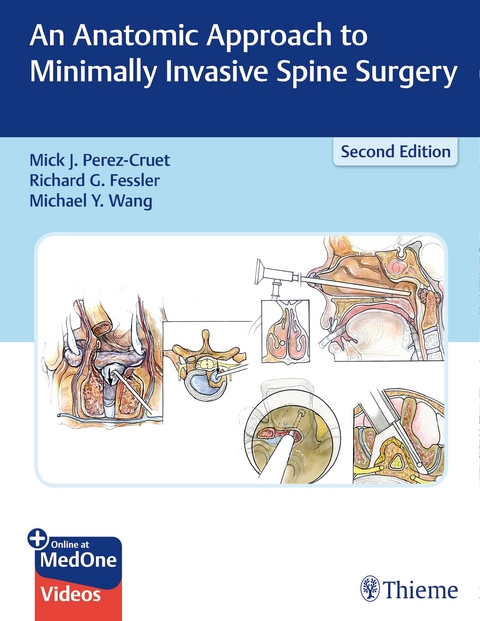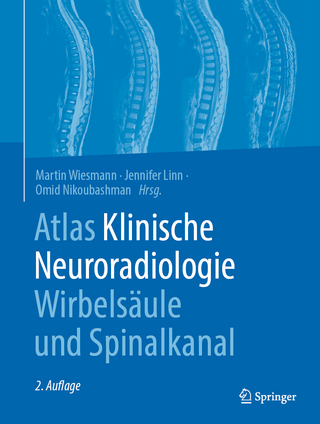
An Anatomic Approach to Minimally Invasive Spine Surgery
Thieme Medical Publishers Inc (Verlag)
978-1-62623-643-1 (ISBN)
Significant advances have been made in minimally invasive spine (MIS) surgery approaches, techniques, and innovative technologies. By preserving normal anatomic integrity during spine surgery, MIS approaches enable spine surgeons to achieve improved patient outcomes, including faster return to normal active lifestyles and reduced revision rates. Exposing only the small portion of the spine responsible for symptoms via small ports or channels, requires a deep understanding of spinal anatomy and spinal pathophysiology. Building on the widely acclaimed first edition, An Anatomic Approach to Minimally Invasive Spine Surgery, Second Edition, provides an expanded foundation of knowledge to master minimally invasive spine surgery.
World-renowned spine neurosurgeons Mick Perez-Cruet, Richard Fessler, Michael Wang, and a cadre of highly regarded spine surgery experts provide masterful tutorials on an impressive array of cutting-edge technologies. Organized by seven sections and 51 chapters, the book presents a diverse spectrum of current safe and efficacious MIS procedures and future innovations. Nonsurgical approaches include injection-based spine procedures and stereotactic radiosurgery. Surgical technique chapters discuss MIS anterior, posterior, and lateral approaches to the cervical, thoracic, and lumbar spine, with procedures such as endoscopic microdiscectomy, vertebroplasty and kyphoplasty, percutaneous instrumentation, and robotic spine surgery.
Key Features
Step-by-step illustrations, including more than 400 depictions by master surgical and anatomic illustrator Anthony Pazos portray the surgeon's-eye-view of anatomy, intraoperative images, and surgical instruments, thereby aiding in the understanding of anatomy and procedures
20 online videos feature real-time operative fluoroscopy, pertinent anatomy, operati
Part I Fundamentals
1 History of Minimally Invasive Spine Surgery
2 Anatomy of the Spine: An Overview
3 Biomechanical Role of the Osseous, Ligamentous, and Muscular Structures of the Spine
4 Pathophysiology and Operative Treatment of Discogenic Back Pain
5 Pathophysiology of Back Pain
6 Rationale for Minimally Invasive Spine Surgery
7 Overcoming the Learning Curve
8 Operating Room Setup
Part II Patient Education and Business Basics
9 Patient Education
10 Establishing an Ambulatory Spine Surgery Center
11 Establishing Ancillary Services and Health Care Regulatory Implications
12 Bringing Novel Spine Devices to the Marketplace
Part III Image Guidance, Monitoring, and Nonoperative Techniques
13 Computer Navigational Guidance in Spine Surgery
14 Intraoperative Monitoring
15 Injection-Based Spine Procedures and Diagnostic Procedures
16 Stereotactic Radiosurgery for Tumors of the Spine
Part IV Surgical Techniques
Section I Cervical Spine
17 Transoral and Transnasal Approaches to the Craniocervical Junction
18 Posterior Cervical Microforaminotomy and Discectomy
19 Posterior Cervical Approach
20 Anterior Cervical Discectomy, Fusion, and Instrumentation
21 Cervical Arthroplasty
22 Cervical Case Studies
Section II Thoracic Spine
23 Posterior Thoracic Microdiscectomy
24 Anterior Thoracoscopic Sympathectomy
25 Thoracoscopic Discectomy and Thoracoscopy-Assisted Tubular Retractor Discectomy
26 Anterior Thoracoscopic Vertebral Reconstruction and Instrumentation
27 Minimally Invasive Deformity Correction
28 Minimally Invasive Treatment of Thoracic and Thoracolumbar Idiopathic Scoliosis
29 Kyphoplasty and Vertebroplasty
30 Minimally Invasive Robotic-Assisted Thoracic Spine Surgery
31 Minimally Invasive Spine Surgery: Thoracic Case Studies
Section III Lumbar Spine
32 Endoscopic Spine Techniques: An Overview
33 Muscle Preserving Lumbar Microdiscectomy
34 Far-Lateral Microdiscectomy
35 Minimally Invasive Laminectomy for Lumbar Stenosis
36 Anterior Lumbar Interbody Fusion
37 Percutaneous Pedicle Screw Placement for Spinal Instrumentation
38 Transforaminal Lumbar Interbody Fusion
39 Transpsoas Anatomical Approach to the Spine
40 eXtreme Lateral Interbody Fusion
41 Trans-sacral Approach
42 Stabilization of the Sacroiliac Joint with the Sacroiliac Bone Surgical Implant
43 Lumbar Disc Replacement: The Artificial Disc
44 Minimally Invasive Spine Surgery: Lumbar Case Studies
Part V Minimally Invasive Spine Surgery for Tumors
45 Advances in Minimally Invasive Surgery for Spine Tumors
46 Benign Spinal Tumors
47 Radiofrequency Tumor Ablation with Vertebroplasty for the Treatment of Spine Metastases
48 Minimally Invasive Resection of Intradural Spinal Tumors
Part VI Complications and Outcome Analysis
49 Clinical Outcome Analyses
50 Avoiding Complications in Minimally Invasive Spine Procedures
Part VII Future Considerations
51 Stem Cell–Based Intervertebral Disc Restoration
| Erscheinungsdatum | 09.01.2019 |
|---|---|
| Zusatzinfo | 439 Illustrations |
| Verlagsort | New York |
| Sprache | englisch |
| Maße | 215 x 280 mm |
| Gewicht | 2087 g |
| Themenwelt | Medizinische Fachgebiete ► Chirurgie ► Neurochirurgie |
| Medizinische Fachgebiete ► Chirurgie ► Unfallchirurgie / Orthopädie | |
| Medizin / Pharmazie ► Medizinische Fachgebiete ► Orthopädie | |
| Medizin / Pharmazie ► Studium | |
| Schlagworte | lumbar spine in minimally invasive spine surgery • maintaining supporting structures of the spine • sparing normal anatomic spinal structures during s • sparing normal anatomic spinal structures during surgery |
| ISBN-10 | 1-62623-643-7 / 1626236437 |
| ISBN-13 | 978-1-62623-643-1 / 9781626236431 |
| Zustand | Neuware |
| Informationen gemäß Produktsicherheitsverordnung (GPSR) | |
| Haben Sie eine Frage zum Produkt? |
aus dem Bereich


